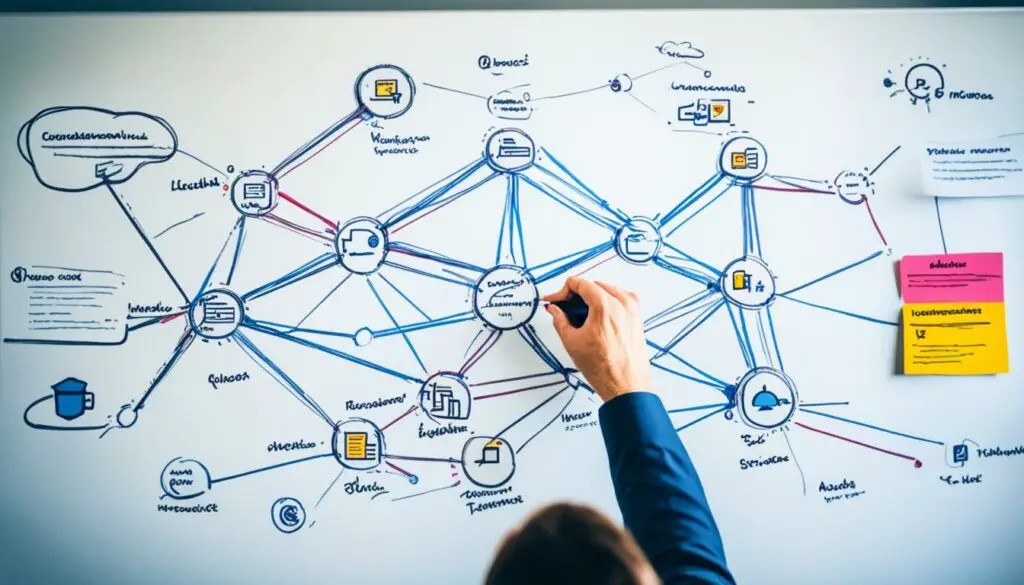Project management is complex. It needs careful planning, coordination, and execution for success. Understanding and managing project interdependencies and dependencies is key.
Interdependencies connect tasks or projects in project management. They include mandatory, discretionary, informational, resource, and external dependencies. Each type affects project flow and progress.
Mandatory dependencies are must-haves for project success. Discretionary dependencies connect tasks logically but are not mandatory.
Informational dependencies share information to support decisions. Resource dependencies occur when multiple projects need the same limited resources. External dependencies rely on work from outside the project team.
Project Management Interdependencies
Project interdependencies and dependencies can greatly influence project success. Delays or conflicts from dependencies can cause project setbacks. Poor communication can also slow down interdependent projects.
Managing interconnected projects adds challenges. Yet, by identifying and managing interdependencies, project teams can reduce risks.
Good interdependency management improves communication and collaboration. It helps in reducing costs and boosting project performance.
Project managers can drive projects to success by managing interdependencies well. Next, we’ll explore different types of project interdependencies and their benefits.
What are Project Interdependencies in Project Management?
Project interdependencies are very important in project management. They affect if a project is successful or not. They are about how different tasks or projects can influence each other.
It’s key to spot and handle these interdependencies to lower risks. This ensures everything in the project goes smoothly.
There are different types of project interdependencies to look out for. Internal ones can come from changes in leadership, budget, or company processes. By managing them, companies can align their projects better and use resources well.
Knowledge-based interdependencies are about using what we’ve learned before. They help project managers avoid problems and find chances to do better. This means making smarter choices based on past project success.
Market-related interdependencies come from changes outside the company. These could be new customer needs or what competitors are doing. Knowing about these helps companies adjust their projects to stay competitive.
Organizational Resource interdependencies are about managing shared resources well. These could be tech, people, or money. Good management here means avoiding delays and keeping projects running smoothly.
Examples of interdependencies include waiting on deliverables from other projects. Or, programmers working on many projects at once. Also, going over budget can slow down related projects. These show how connected projects are and their impact on each other.
To handle project interdependencies well, companies need solid risk management. They can use tools like Gantt charts, Project Charter, Trello, Asana, and Jira. These tools help see and manage dependencies for better planning.
Managing project interdependencies well makes planning better. It also improves how projects are managed, lowers risks, and uses resources best. This way, companies can reach their project goals.
Types of Project Interdependencies
Managing projects means understanding various interdependencies that can affect success. These interdependencies may come from different sources and significantly impact planning and results. We’ll look into four main types: corporate, knowledge, market, and organizational resource interdependencies.
Corporate Interdependencies
Corporate interdependencies are changes within an organization that can impact projects. They can be changes in leadership, budgets, processes, or structure. For instance, a new company leader might change priorities or move resources, which affects ongoing projects.
Knowledge Interdependencies
Knowledge interdependencies use past project insights to improve current projects. By learning from previous successes and failures, teams can avoid issues and spot chances. This knowledge is shared via lessons learned sessions, best practices, or project management methods.
Market Interdependencies
Market interdependencies are external factors affecting projects. They may be shifts in customer wants, market demands, resource availability, or competition. For example, new tech or consumer trends might mean projects need adjusting to meet new market needs.
Organizational Resource Interdependencies
Organizational resource interdependencies happen when projects need the same critical resources. These could be tech systems, staff, budgets, or materials. If these resources are scarce, it might lead to scheduling issues, limits, or delays.
By managing these interdependencies well, project managers can lessen risks, optimize resources, and improve project success. Now, we’ll discuss examples of project interdependencies in different industries.
Examples of Project Interdependencies
Project interdependencies are key for complex projects. They happen when tasks, teams, or resources need each other to finish. Here, we’ll look at some examples.
1. Project Start Dependency
A project can’t begin until another finishes certain tasks. For example, building a house waits on the architectural design and getting permits from the urban department.
2. Resource Sharing
Resources like a graphic designer might be needed for two projects at once. This requires good coordination and deciding which project is top priority.
3. Budget Impacts
Changes in one project’s budget can affect others. If a manufacturing plant construction gets delayed, it can increase the budget for setting up the production line.
These cases show how tasks, teams, and resources are all connected in projects. Managing these links well is vital for project success.
Understanding Project Dependencies
Project dependencies are crucial in project management because they set the order for completing tasks. They are tasks that need other tasks to be finished first. Or they are activities that can’t start until another is finished.
Managing these dependencies is key to a project’s success. It helps meet goals or avoid failure. By managing these well, project managers keep tasks in order and avoid resource clashes. This makes the project run smoother.
Projects have internal and external dependencies. Internal ones are tasks within the project that depend on each other. External ones are outside factors that might affect the project.
It’s the Project Manager’s job to handle these dependencies. They track tasks and make sure projects are done within their limits. This helps the project hit its goals on time and within budget.
Keeping an eye on dependencies through the project is vital. This helps catch and fix risks early. For big IT projects, missing these can cause big delays and extra work.
Sometimes, people might not want to spend time identifying dependencies. For instance, during COVID-19, some hesitated to talk about supply chain risks. But being thorough and talking openly helps spot risks and opportunities. It also helps teams work together and find creative solutions.
Handling dependencies right is crucial for success. It can affect many aspects of the project. Good management helps reduce risks, improve teamwork, and keep goals aligned.
When many projects run together, managing dependencies gets complex. Bad management can hurt the company’s overall plan. Skilled project managers are needed to handle these challenges well.
The Project Management Office (PMO) plays an important part too. They help by tracking and providing feedback. The PMO also ensures problems and delays are handled well. This supports the project’s success.
Types of Project Dependencies
Project management is all about dealing with different dependencies. Knowing the types of project dependencies is key for smooth project management. This knowledge helps in completing projects successfully.
External Dependencies
External dependencies come from outside the organization. They include market demands or legal rules. These factors can change project timeframes and what we deliver. It’s important to consider them in project planning.
Corporate Interdependencies
Corporate interdependencies are about changes inside the organization affecting projects. This includes new leadership, budget changes, or new processes. Such changes can alter project progress and the resources we have.
Knowledge Interdependencies
Knowledge interdependencies use what we learned from past projects to improve current ones. Teams use previous experiences, best practices, and technical know-how. This helps make projects run smoother and more effectively.
Organizational Resource Dependencies
Organizational resource dependencies happen when there are not enough resources for all projects. We have to use shared services and resources wisely. This helps prevent issues and makes sure resources are used well.
Task Scheduling Dependencies
Task scheduling dependencies are about how project tasks relate. Types include finish-to-start (FS), start-to-start (SS), finish-to-finish (FF), and start-to-finish (SF). They help plan the order to do tasks in. This is important for organizing projects well.
Examples of Project Dependencies
Various situations can lead to project dependencies, which affect how tasks are completed. It’s important to understand these dependencies for effective project management. Here, we’ll look at some common types:
1. Logical Dependency
Logical dependencies happen based on the task order in a project. One task needs finishing before another can start. For instance, in software development, coding must be done before testing can start.
2. Discretionary Dependency
Discretionary dependencies are choices made to improve the project. They’re not needed but helpful. Choosing a special software tool to boost work efficiency is an example.
3. Resource-Based Dependency
Resource-based dependencies occur when projects or tasks need the same scarce resources. If two projects need the same software developer, the second must wait until the first is done.
4. Internal Dependency (Cross-Team Dependency)
Internal dependencies come up in projects with multiple teams. They depend on teams working together. The marketing team might need the design team to finish their visuals first, for example.
5. External Dependency
External dependencies are outside the business’s control but affect timelines. These can include waiting for third-party approvals or dealing with government rules. Adverse weather can delay a construction project, as another example.
Benefits of Managing Project Interdependencies and Dependencies
Managing project interdependencies and dependencies leads to many benefits. Proper management can save time and costs significantly. By figuring out how tasks depend on each other, managers can make everything run smoother.
Improving risk control is a big advantage of handling these dependencies. By identifying how tasks are connected, managers can spot problems before they happen. This lets them prepare strategies to minimize risks.
Another benefit is better scope management. Dependencies help understand how changes affect the project. This ensures that any change fits well without causing issues. It keeps the project on track without letting it grow out of control.
Handling dependencies also boosts leadership and teamwork. It needs good coordination and communication among everyone involved. Through managing these relationships, people build their leadership skills and work better together.
Moreover, it leads to better teamwork and productivity. When everyone knows how their work relates, coordination improves. This efficiency cuts down on unnecessary work and uses resources wisely.
Conclusion
Understanding project interdependencies and dependencies is key to success. It’s crucial for a project’s timely completion and risk control. By managing these well, project managers can boost outcomes, avoid delays, and improve performance.
A Notion template helps effectively manage these dependencies. It allows you to see and take care of project needs. This template has parts for listing dependencies and handling them, whether in or out of team control. It assigns responsibility to make managing easier.
This tool helps keep track of many dependencies without missing anything important. It’s great for those leading projects or dealing with risks. It helps teams foresee and manage stuff that could affect their project, pushing them towards success.
To wrap up, good management of project relations is vital for meeting goals. Using tools like a Notion template helps a lot. It makes team discussions more focused and keeps everyone on the same page. Visual aids improve memory and understanding, boosting project success.




